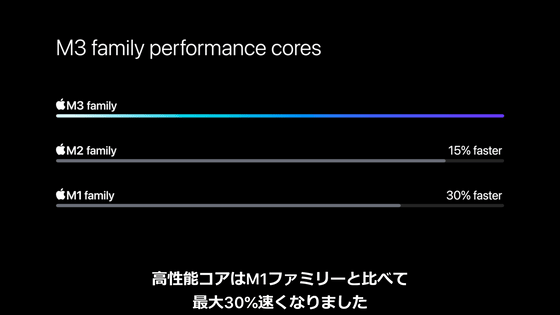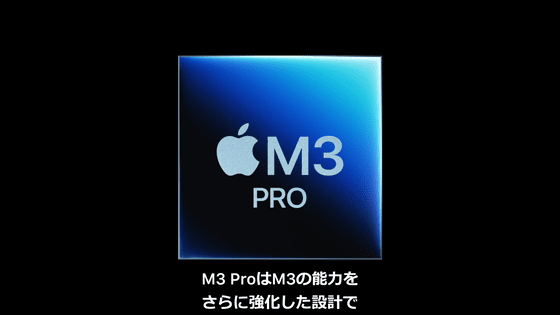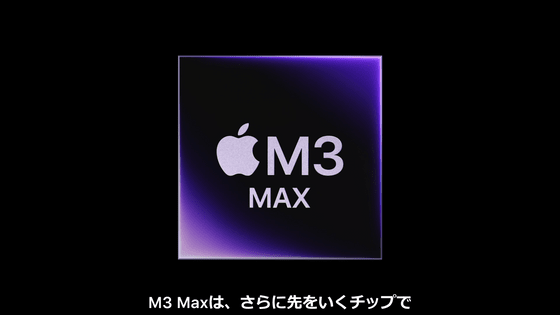Apple announces the next generation M series 'M3', 'M3 Pro', and 'M3 Max', the first 3nm process chip for Mac

At Apple's new product announcement event held on October 31, 2023, three next-generation Apple silicon chips, the M3 , M3 Pro , and M3 Max , were announced at the same time. The M3 series is the first Apple silicon chip for Mac manufactured using the 3nm process.
Apple unveils M3, M3 Pro, and M3 Max, the most advanced chips for personal computers - Apple (Japan)
https://www.apple.com/jp/newsroom/2023/10/apple-unveils-m3-m3-pro-and-m3-max-the-most-advanced-chips-for-a-personal-computer/
Apple Event - October 30 - YouTube
The new M3 family is said to be the biggest evolution of Apple silicon ever.

The M3 family is the first PC chip to use 3nm technology.

By using the latest extreme ultraviolet lithography, it is now possible to manufacture microscopic transistors that are so small that 2 million transistors can be integrated into a space the size of a cross section of a hair.

This cutting-edge transistor is used to advance every element of the new chip, giving every chip in the M3 family greater performance and new features.

The M3 family of chips features a next-generation GPU with a graphics architecture that represents the biggest leap forward in the Apple silicon market.

The new microarchitecture is equipped with a revolutionary feature called Dynamic Caching, an industry first.

In traditional graphics architectures, software decides at compile time how much local GPU memory to allocate to upcoming tasks.

Therefore, the same amount of memory was reserved for each task based on the single task with the heaviest load.


This does not fully utilize the GPU. Especially in complex programs.

Therefore, next-generation GPUs that support dynamic caching dynamically allocate local memory in real time in hardware. As a result, only the amount of memory needed for each task is used.

This dramatically increases average GPU utilization, greatly improving performance in the most demanding professional apps and games.

Dynamic caching is an industry first, highly transparent to developers, and the foundation of Apple's new GPU architecture.

Such next-generation GPUs bring new rendering capabilities to Apple silicon.

For example, hardware accelerated mesh shading. This method brings hardware-accelerated raytracing to Mac for the first time by increasing the power and efficiency of geometry processing.


Ray tracing allows games to more accurately render shadows and reflections as they interact with the scene.

Professional 3D rendering apps can generate beautiful ray-traced images at lightning speed.

Combining hardware-accelerated ray tracing and a new graphics architecture, the M3 family delivers up to 2.5x faster rendering performance than the M1 family. Succeeded in speeding up to 1.8 times compared to the M2 family

This makes the most demanding graphics processing much faster.

A revolutionary new GPU architecture takes your Mac's graphics performance to another level.

About the next generation CPU core of the M3 family.

The high-performance core is up to 30% faster than the M1 family and up to 15% faster than the M2 family. Yet power efficiency remains at the same level as before.

The performance of the high-efficiency cores has further improved, making them up to 50% faster than the M1 family and up to 30% faster than the M2 family.

Despite improvements in architecture and performance, the industry-leading performance per watt remains as high as ever.

Comparing M3's CPU performance with M1's CPU is as follows. Only half the power is required to deliver the same multi-threaded CPU performance.

Below is a graph comparing the GPU performance of M1 and M3, and the GPU requires half the power consumption to achieve the same performance as M1.

In other words, the performance per watt has been greatly improved for both CPU and GPU.

Compared to other companies' latest 12-core CPU-equipped notebook PCs, it consumes only one-fourth the power required to achieve the same CPU performance.

What's more, when comparing GPU performance, it takes only 5 times less power to achieve the same performance.

The M3 series also features a faster and more efficient Neural Engine.

Neural Engine performance is up to 60% faster than the M1 family and up to 15% faster than the M2 family.

This improves the performance of AI tools, but also protects privacy as the data processed remains on the device.

The M3 family also features Apple's advanced media engine, which enables AV1 support in addition to hardware acceleration of popular video codecs. Enables video streaming playback of YouTube, Netflix, etc. while maintaining high power efficiency.

Apple's scalable architecture allows each M Series chip to fit a variety of needs, delivering the best features to every user.

The M3 has an 8-core CPU (4 high-performance cores, 4 high-efficiency cores), 10 GPU cores, and up to 24GB of unified memory. This makes it up to 65% faster than M1.

The M3 Pro is a design that further enhances the capabilities of the M3 and is a model for users who require higher performance.

The CPU has 12 cores (6 high-performance cores, 6 high-efficiency cores), the GPU has 18 cores, and the unified memory is up to 36GB. This seems to make it up to 40% faster than the M1 Pro.

The M3 Max is an even higher spec chip, making it suitable for the most demanding professional work.

The CPU has 16 cores (12 high-performance cores, 4 high-efficiency cores), the GPU has 40 cores, and the unified memory is up to 128GB.

Up to 128GB of unified memory allows AI developers to work with huge Transformer models with billions of parameters.

M3 Pro is up to 80% faster than M1 Max.

Apple claims that performance has improved dramatically in just two years since the introduction of M1.

The M3 series is the first Apple silicon for Mac manufactured using the 3nm process. Both the M1 family and M2 family were manufactured using the 5nm process.

Apple concludes the announcement by touting the M3 family as 'the most advanced personal computer chips ever.'

Related Posts:




